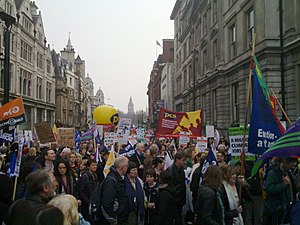| Anti-austerity movement in the United Kingdom | |
|---|---|
| Part of the impact of the Great Recession | |
 Demonstrators march along Whitehall on 26 March 2011 | |
| Date | 10 November 2010 – present |
| Location | |
| Caused by | Austerity |
| Methods | Demonstrations, strike action, sit-ins, occupations, rioting |
| Anti-austerity protests in the European Union |
|---|
| By member state |
| Principal protest parties |
The anti-austerity movement in the United Kingdom saw major demonstrations throughout the 2010s in response to Conservative-Liberal Democrat coalition government's austerity measures which saw significant reductions in local council budgets, increasing of university tuition fees and reduction of public spending on welfare, education, health and policing, among others. Anti-austerity protests became a prominent part of popular demonstrations across the 2010s, particularly the first half of the decade.[1]
UK trade unions, and the Trade Union Congress took a large role in supporting the movement. Organisations that formed during the movement- such as People's Assembly Against Austerity, UK Uncut, the National Campaign Against Fees and Cuts, Scotland United against Austerity, the Radical Assembly and the Occupy London Stock Exchange have all been seen as key in the movement's growth and activities.[2][3][4]
- ^ Cite error: The named reference
OD-DecadeofDissentwas invoked but never defined (see the help page). - ^ Cite error: The named reference
LSB-TCoAAPwas invoked but never defined (see the help page). - ^ Sophie Hatzisavvidou, Sophie (18 January 2018). "Truth-tellers: creating Britain's anti-austerity campaign". British Politics and Policy at LSE. Retrieved 25 April 2020.
- ^ Maiguashca, Dean & Keith 2016, p. 1.
